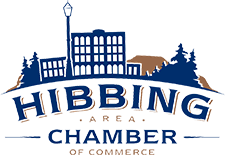800 East 21st Street, Hibbing, 218-208-0841
Entrance Murals - As you walk into the Hibbing High School's main entrance, you are greeted by two sets of three mural panels. One set to your left and right. David Ericson, a Duluth painter, painted the six murals in 1924. The murals on the west wall trace the history of Minnesota. The first mural is of Minnesota's fur trading roots as a territory. The second is of its recognition as a state. The third is Minnesota's first major industry, logging. On the east wall, the mural set traces United States' history. The first mural shows Columbus discovering America. The second is the signing of the Declaration of Independence. The third depicts westward expansion. The Smithsonian recognizes these murals as national treasures. They are also registered with our nation's archives.
The Auditorium- The Hibbing High School Auditorium was modeled after The Capitol Theater in New York City. Between the main floor and the balcony, it seats up to 1,805. A twenty-foot by forty-foot proscenium arch, whose borders are marked by massive pillars, frames the stage. Artist Carl Hardolf A. Parson painted four female figures, representing music, art, drama, and literature. The muses of the arts preside over the auditorium from high upon its walls. Greek urns with flowering acanthus leaves and swags, all surrounding multi-colored Sheraton medallions decorate an “Adam” style ceiling. The ceiling makes a perfect backdrop for the four giant solid glass chandeliers. The chandeliers were installed in 1924 to the tune of $4,000 a piece. Each main chandelier stretches seven feet across and weighs nearly six hundred pounds.
Library Art- The Hibbing High School Library is home to many pieces of extraordinary works of art. The main room of the library houses many statues of famous authors and presidents, including Presidents George Washington and Abraham Lincoln. It also has murals with literary themes and bas-relief panels of children joyously celebrating. It is also home to the mural listed below.
Mining Mural- As you transition from the main section of the library to the darker back room, you are met by the equally dark sixty-foot mural entitled “The Iron Industry” that makes a statement on the west wall. This piece initially hung in the old Lincoln High School. David Tice Workman, a painter from Howard Lake Minnesota, painted it in 1913. Workman cleverly divided the mural into three sections by two verticals—A pole and a chain—the painting follows the process of converting raw iron ore into steel. Sixteen life size figures, each representative of a differing nationality that settled the area, “work” in the print at varying tasks associated with mining. Step one in the mining process was obtaining the raw product, comes alive to the left, two types of ore extraction are shown in the painting. Underground mining is represented in the back of this section by the head frame, which housed winches to raise and lower workers and ore in and out of the mine tunnels. Strip mining is represented by the original steam shovel stripping away the worthless bits of earth to reveal the ore. In the second panel, a huge Malley steam engine hauling filled ore cars represents the start of the transportation portion of the process. The trains’ usual destination was the Duluth-Superior harbor, from which the ore would be brought by ship to the steel mills of Detroit or Pittsburgh. The third panel portrays those mills. In the mural you can see large cranes first unloaded the ore from ships, dumping it into huge piles where it would later be mixed with limestone and coke as part of the basic “recipe” for converting the raw ore into iron. Adjacent to the mural is a quote by Tennyson “Mines undrainable of ore.” This mural is registered with the Superintendent of Documents and the Smithsonian in Washington D.C.
